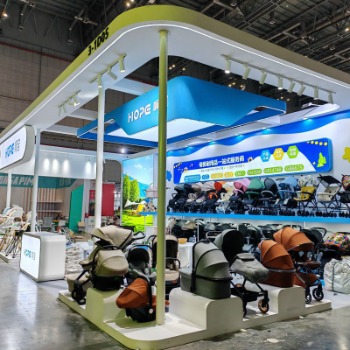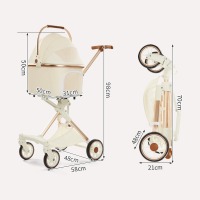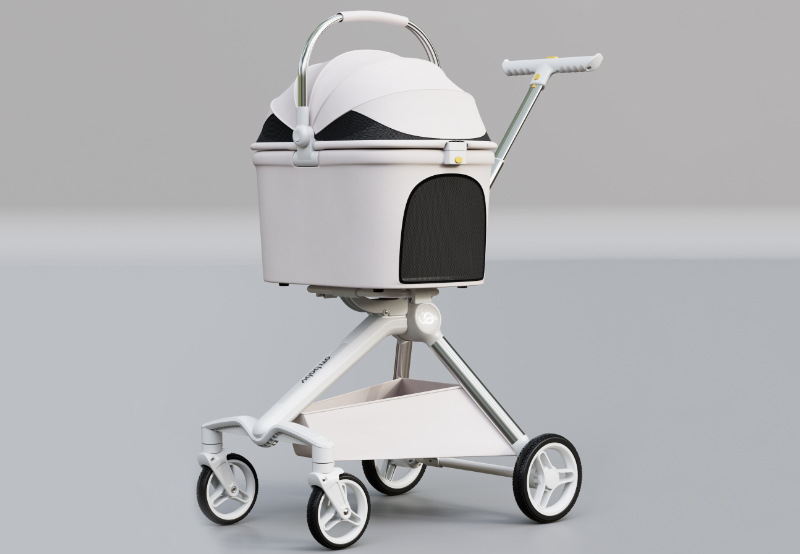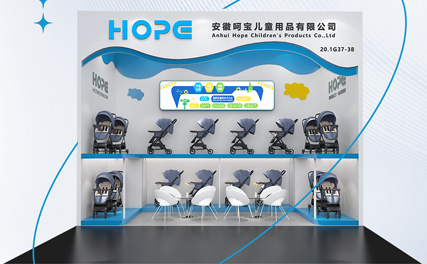As the pet industry has developed, more and more pet owners are choosing to place their dogs in strollers. Using a pet stroller can help dogs better adapt to the outside environment, especially for elderly, frail, or injured pets. A pet stroller provides a more comfortable, safe, and convenient way for them to go out. Additionally, pet strollers can enhance the interaction between owners and pets, improving their quality of life. However, the use of a pet stroller should be considered based on the dog's personality, health condition, and living environment, ensuring it does not have a negative impact on the pet's behavior or health.
Is it beneficial to put a dog in a stroller, and is it suitable for all types of dogs?

Advantages of Putting Your Dog in a Stroller
1. Improve your pet's comfort
Health issues: Elderly dogs, dogs with limited mobility, or dogs who are injured may not be able to walk for long periods of time. Pet strollers provide an easy way for them to enjoy outdoor activities without exerting physical energy.
Weather protection: In hot or cold weather, pet strollers can provide shelter and protection from exposing pets to unsuitable environments.
2. Provide a sense of security
Avoid danger: Pets may feel anxious or stressed on busy streets or in crowded places. Pet strollers can help them stay away from potential dangers, such as crowded people or other excited animals.
Avoid overstimulation: Some dogs are easily nervous about external noise, traffic, or other stimuli. Putting them in pet strollers can provide them with a relatively quiet and safe environment.
3. Ease of control and management
Reduce the risk of escape: When out and about, especially in crowded places, pet strollers can prevent pets from running away or losing control.
Save energy: For some dogs, long walks may be too tiring. Owners can put them in pet strollers to reduce their fatigue while ensuring that they can still enjoy the stimulation of the outside world.
4. Convenient to carry and go out
Suitable for short trips: If the owner needs to take the dog to places such as shopping malls and parks, a pet stroller can avoid long walks and is also convenient for taking the pet on public transportation.
Versatility: Some pet strollers are well-designed and have storage space, which makes it convenient for the owner to carry dog food, water, toys and other items, suitable for short trips or long outings.
5. Enhance interaction and companionship
Take pets out: Even if the dog cannot walk for a long time due to health problems, the owner can still take them out in a pet stroller to enjoy the sun and air, enhance interaction with the pet, and enhance affection.
Suitable for small dogs: Many small dogs have limited physical strength. Putting them in a pet stroller can not only allow them to feel the outside world, but also avoid excessive fatigue.
6. Suitable for special situations
Pets in recovery: For dogs that have been injured or have just undergone surgery, pet strollers can help them maintain a certain amount of activity during recovery without adding too much exercise burden.
Small or elderly dogs: Some small or elderly dogs have limited range of activities, and pet strollers allow them to enjoy going out without long walks.
7. Convenient for daily life
Help socialization: Some dogs are naturally shy or have not been fully socialized in adulthood. Pet strollers allow them to observe the world around them in a safe environment and gradually adapt to people and other animals in the outside world.
Easily manage multiple pets: For families with multiple dogs, using a pet stroller can make it easier for the owner to manage and care for each dog.
The disadvantages of Putting Your Dog in a Stroller
Limiting pets' movement and freedom
Pets usually like to explore and move around, and placing them in a stroller may limit their range of movement and freedom, preventing them from fully exercising their physical strength and nature.
Limited social interaction
Dogs are social animals, and they need to interact with other dogs and people to meet their social needs. Placing dogs in strollers may reduce their opportunities to interact with their surroundings, leading to reduced social interaction.
Lack of stimulation and cognition
Pets need stimulation and cognition to maintain physical and mental health. Placing them in strollers may limit their ability to contact the outside environment, experience new things, and explore the world.
Adaptability issues
Dogs are usually not trained to adapt to strollers, and placing them in unfamiliar environments may cause stress and anxiety. Some dogs may feel uncomfortable or afraid of strollers, resulting in adverse reactions or behavioral problems.
Which dogs are suitable for a stroller?
Different breeds and individuals of dogs have different sizes, health conditions, and behavioral needs. Not all dogs are suitable for being placed in strollers, and some dogs may feel crowded, uncomfortable, or unsafe.
Strollers are not only for taking care of babies, they can also be a useful tool for pets, especially dogs. Especially for some weak, elderly, or dogs with special needs, strollers can provide a safe and comfortable way to go out, helping them enjoy the outdoors while avoiding excessive fatigue. Here are some types of dogs that are suitable for strollers:
1. Senior dogs
For elderly or weak dogs, especially those who have difficulty moving or are easily tired, strollers are an excellent choice. As they age, dogs' joints, muscles, bones and other body functions gradually deteriorate, and they may have problems such as arthritis, muscle atrophy, vision or hearing loss. Long walks or strenuous activities may make them tired or uncomfortable. Therefore, when elderly dogs go out, strollers can provide them with a comfortable resting space to avoid the discomfort caused by strenuous exercise, while also allowing them to continue to enjoy the fresh air and sunshine outside.
Applicable scenarios: Daily walks for elderly dogs to avoid physical stress caused by excessive exercise.
2. Small dogs
Small dogs, especially those with small bodies and short legs, such as Chihuahuas, Pomeranians, and Yorkshire Terriers, are usually more adaptable to strollers than large dogs. Their size makes it more difficult to walk or run for long periods of time and they are prone to fatigue. Strollers not only reduce their walking burden, but also provide them with a safer environment for going out. Small dogs are particularly prone to stress from other larger dogs or traffic situations, so being placed in strollers can avoid these potential risks.
Applicable scenarios: daily walks, avoiding excessive exercise, and staying safe.
3. Injured or recovering dogs
If a dog needs to recover after surgery or injury, a stroller can provide it with an ideal tool for going out. Many times, injured dogs may need to limit their activity to prevent excessive exercise burden on the wound or fracture site. Strollers not only ensure the safety of dogs, but also reduce their discomfort during recovery. Dogs can rest comfortably in the car while still enjoying the experience of going out with their owners.
Applicable scenarios: postoperative recovery period, limited activity after injury.
4. Small healthy dogs and active dogs
Some healthy small dogs or active dogs, especially those who are naturally energetic, may feel tired during long walks or trips. For such dogs, strollers are also a suitable auxiliary tool. During long trips or travels, dogs can rest in strollers while their owners can continue to walk. For dogs who are very curious and like to go out but cannot walk for a long time, strollers provide a good solution.
Applicable scenarios: long-distance travel, shopping, avoiding excessive fatigue.
5. Dogs with phobias or anxiety
Some dogs may feel anxious and uneasy because of the environment, sounds or unfamiliar places. Especially in crowded or noisy environments, dogs may become very nervous and may even react by attacking or running away. Strollers can provide these sensitive dogs with a relatively closed and safe space, keeping them away from external interference and threats, thereby reducing their anxiety levels.
Applicable scenarios: avoid panic in crowds and avoid overly stimulating environments.
6. Long-haired dogs or breeds that are susceptible to heat
Some long-haired breeds (such as golden retrievers, huskies, etc.) or those that are prone to overheating may feel uncomfortable in hot weather. Long walks or outdoor activities will expose them to the sun, which can easily cause heat stroke or excessive fatigue. Strollers can provide these dogs with shelter and reduce the time they are exposed to the sun. At the same time, they can stop at any time to provide them with rest, helping them better control their body temperature.
Applicable scenarios: hot weather, long outdoor activities.
7. Dogs with unique needs (such as dogs with special diseases)
Some dogs may have special health conditions, such as heart disease, respiratory problems, allergic diseases, etc. Strollers can help these dogs avoid overwork and ensure that they get enough rest when they go out. For example, dogs with heart disease may not be able to withstand long walks or strenuous activities. Strollers can provide an easy way to go out.
Applicable scenarios: Dogs with special health problems such as heart disease and respiratory diseases.
How to choose the right dog stroller?
1. Consider the size and weight of the dog
Choose the right stroller size to ensure that the dog has enough space.
2. Comfort
The seat of the stroller should be padded and breathable to avoid overheating.
3. Adjustability
A stroller suitable for different scenarios, such as adjustable seat angles and a stable brake system.
4. Safety
Make sure the stroller has appropriate seat belts to prevent the dog from jumping out or having accidents.
A dog stroller is a very practical tool, especially for dogs that are old, weak, injured or have special health needs. It can provide a safe and comfortable way to go out. Although using a stroller can improve the comfort of dogs and help them adapt to the external environment, it is not suitable for all dogs. Owners need to carefully choose whether to use a stroller based on the size, health and personality characteristics of the dog to ensure that it does not affect the dog's exercise, social and cognitive needs.
...

















